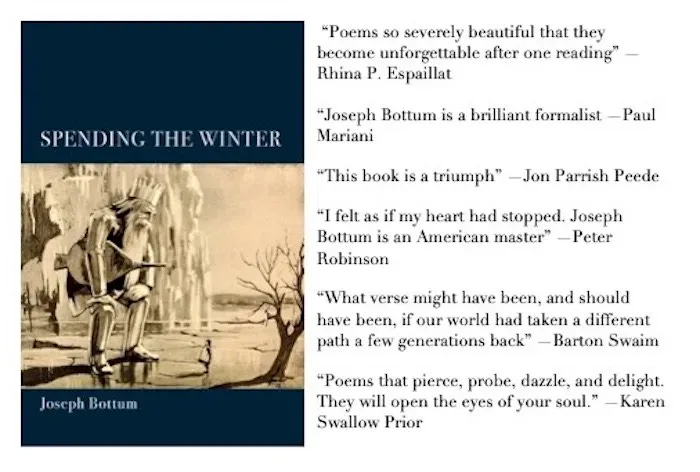
I Am the Living Bread: Meditation Eight: John 6:51
by Edward Taylor
I kening through Astronomy Divine ◦ kening = perceiving, knowing The Worlds bright Battlement, wherein I spy A Golden Path my Pensill cannot line, From that bright Throne unto my Threshold ly. And while my puzzled thoughts about it pore I finde the Bread of Life in’t at my doore. When that this Bird of Paradise put in This Wicker Cage (my Corps) to tweedle praise Had peckt the Fruite forbad: and so did fling Away its Food; and lost its golden dayes; It fell into Celestiall Famine sore: And never could attain a morsell more. Alas! alas! Poore Bird, what wilt thou doe? The Creatures field no food for Souls e’re gave. And if thou knock at Angells dores they show An Empty Barrell: they no soul bread have. Alas! Poore Bird, the Worlds White Loafe is done And cannot yield thee here the smallest Crumb. In this sad state, Gods Tender Bowells run ◦ Bowells = “seat of compassion” Out streams of Grace: And he to end all strife The Purest Wheate in Heaven, his deare-dear Son Grinds, and kneads up into this Bread of Life. Which Bread of Life from Heaven down came and stands Disht on thy Table up by Angells Hands. Did God mould up this Bread in Heaven, and bake, Which from his Table came, and to thine goeth? Doth he bespeake thee thus, This Soule Bread take. Come Eate thy fill of this thy Gods White Loafe? Its Food too fine for Angells, yet come, take And Eate thy fill. Its Heavens Sugar Cake. What Grace is this knead in this Loafe? This thing Souls are but petty things it to admire. Yee Angells, help: This fill would to the brim Heav’ns whelm’d-down Chrystall meele Bowle, yea and higher. ◦ meele = flour This Bread of Life dropt in thy mouth, doth Cry. Eate, Eate me, Soul, and thou shalt never dy. ═══════════════════════
Like his older contemporary Anne Bradstreet (1612–1672), Edward Taylor (1642–1729) was an English Protestant nonconformist transplant to Puritan New England. A Leicestershire farmer and schoolteacher, he had prospered under the regime of Oliver Cromwell. But after the Restoration of the Stuart monarchy in 1660, unable for reasons of conscience to sign the 1662 Act of Uniformity, imposing the rites of Anglican Book of Common Prayer as the sole standard for religious practice in England, Taylor sailed in 1668 for the Massachusetts Bay Colony.
Almost immediately upon his arrival, he enrolled as a student at Harvard College, where he intended to remain as a resident scholar. Instead, days after his institution as scholar, he assented to a call to the ministry, to serve the Congregational church at Westfield, Massachusetts, as pastor and physician. There he spent the rest of his life, marrying twice and burying five of his eight children, as well as his first wife.
As a poet, he looked not only to the obvious Puritan models, Milton and Bunyan, but also to the Metaphysical poets of the early 17th century, particularly George Herbert, whom he revered despite his disagreements with Herbert’s Anglican doctrine. Today’s Poem comes from a series of roughly two hundred poems, composed between 1682 and 1725, which Taylor collected in leatherbound volumes (though he instructed his heirs not to publish them) under the title Preparatory Meditations before my Approach to the Lord’s Supper. “I Am the Living Bread” responds, as its subtitle indicates, to John 6:51, in which Jesus, having fed the five thousand the previous day by the miraculous multiplication of loaves and fishes, declares himself to be the “living bread which came down from heaven.”
In six ababcc iambic pentameter sestets — sometimes called “heroic sestets” — this meditation emphasizes the goodness and mercy of God, who takes pity on the sinner whose fallen state is both an exile from paradise and a “famine.” Earthly life itself is an imprisonment for the soul, the “Bird of Paradise,” which finds itself in the “wicker cage” of the body, where it is meant to “tweedle praise,” but instead pecks at forbidden fruit, which does not satiate. Instead, the soul turns from its proper food and begins to starve. Even the angels have no “soul bread” to offer.
The first three stanzas unfold this predicament. The fourth begins the predicament’s resolution, with an image that might startle us initially — God’s “Tender Bowells” running with soul-sustenance — until we recall the biblical figure of the “bowels of compassion” in 1 John 3:17. The Greeks viewed the intestines as the locus of anger and other “violent passions,” while for Hebrew writers the bowels represented “the seat of the tender ‘affections.’” So the image on which the poem turns toward its conclusion is meant simply to emphasize that God’s nature is to have mercy — to stream with “Grace” — and that this is the source by whose action “his deare-dear Son” becomes a new kind of manna and more: “Heaven’s sugar-cake.”
The final stanza enacts what the first lines of the first stanza evoke: that mysterious “Golden Path” connecting heaven and earth — not only earth, but the individual earthbound soul that starves for heaven. The “Loafe” of divine bread is a “thing,” while the soul also is a “thing,” however “petty,” made to “admire” it. Though fallen, the soul shares its substance with its savior. The slant a-rhyme in this stanza, “thing/brim,” recalls a similar set of slant a-rhymes in stanza 2: “in/fling.” The first set of rhymes corresponds to the action of sin; the rhymes in the concluding stanza, with their reversed order, are bound up with the redemptive action that undoes the prior action. As a mother bird feeds her young, the Living Bread offers itself, saying, “Eate, Eate, me, Soul, and thou shalt never dy.”






Stunning. So glad to have been introduced to this poem.
Our fine heritage. Thank you.